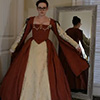Home
 Tudor clothes include the outfits used at the Court of King of England Henry VIII. Both male and female garments are ornate, noble-looking, and expensive. But today, we’ll talk about one of the women’s gowns. Let’s look at the pieces of a Tudor French dress and find out how to put them on correctly. The curious thing about this attire is the sleeves that are worn separately from the main dress.
Tudor clothes include the outfits used at the Court of King of England Henry VIII. Both male and female garments are ornate, noble-looking, and expensive. But today, we’ll talk about one of the women’s gowns. Let’s look at the pieces of a Tudor French dress and find out how to put them on correctly. The curious thing about this attire is the sleeves that are worn separately from the main dress.
- Details
- Category: Nationalclothing
- Hits: 5390
 Norwegian traditional costume – bunad – looks very elegant and sophisticated. It is rather simple in wearing but still, there are few tricks that you should know about. Today, we’ll show you how to put on a women’s bunad from Sunnmore region, the southernmost district of the western Norway.
Norwegian traditional costume – bunad – looks very elegant and sophisticated. It is rather simple in wearing but still, there are few tricks that you should know about. Today, we’ll show you how to put on a women’s bunad from Sunnmore region, the southernmost district of the western Norway.
- Details
- Category: Norway
- Hits: 8231
 Mongolian traditional male clothes aren’t very diverse. Many garments look rather alike for a foreigner, but locals differentiate them all right. Let’s find a difference between two popular Mongolian coats: a terleg and a deel. Meanwhile, we’ll get to know and understand these nomadic people better.
Mongolian traditional male clothes aren’t very diverse. Many garments look rather alike for a foreigner, but locals differentiate them all right. Let’s find a difference between two popular Mongolian coats: a terleg and a deel. Meanwhile, we’ll get to know and understand these nomadic people better.
- Details
- Category: Mongolia
- Hits: 25258
 Qixiong Ruqun is a nice Chinese garment with a surprising background. There is a special reason why its waistband is above the breasts. And you’ll be surprised by this reason. Intrigued? Then read on. We’ll also show you how to put this delicate garment on considering all of the rules and peculiarities.
Qixiong Ruqun is a nice Chinese garment with a surprising background. There is a special reason why its waistband is above the breasts. And you’ll be surprised by this reason. Intrigued? Then read on. We’ll also show you how to put this delicate garment on considering all of the rules and peculiarities.
- Details
- Category: China
- Hits: 9116
 Around the world, the white dress dominates wedding fashion. Though, many brides throughout Asia wear traditional cultural gowns instead of the white dresses. Folk wedding dresses often are much more impressive than the ordinary white gowns. Need some proof? Here you are a bundle of photos.
Around the world, the white dress dominates wedding fashion. Though, many brides throughout Asia wear traditional cultural gowns instead of the white dresses. Folk wedding dresses often are much more impressive than the ordinary white gowns. Need some proof? Here you are a bundle of photos.
- Details
- Category: Nationalclothing
- Hits: 4135
 Traditional pieces of the male and female national costumes in Palestine: abaya, bisht, burnous, bushnika, damer, dimaya, hata wi ‘agal, izar, jallayeh, jubba, jubbeh, khabara, kuffiyah, laffeh, lavandi, malliaia, qamis, qibar, qumbaz, salta, sirwal, tarbush, tatriz, taqiyyah, taqsireh, and thob.
Traditional pieces of the male and female national costumes in Palestine: abaya, bisht, burnous, bushnika, damer, dimaya, hata wi ‘agal, izar, jallayeh, jubba, jubbeh, khabara, kuffiyah, laffeh, lavandi, malliaia, qamis, qibar, qumbaz, salta, sirwal, tarbush, tatriz, taqiyyah, taqsireh, and thob.
- Details
- Category: Palestine
- Hits: 5409
 It’s not too difficult to put on a male kimono – the traditional Japanese costume. But still, you have to wear every piece of the outfit right to avoid being laughed at. Here are some hints from a native Japanese that will help you use the men’s kimono perfectly.
It’s not too difficult to put on a male kimono – the traditional Japanese costume. But still, you have to wear every piece of the outfit right to avoid being laughed at. Here are some hints from a native Japanese that will help you use the men’s kimono perfectly.
- Details
- Category: Japan
- Hits: 12401
 The pilgrims. What did they look like? And, more important, what did they wear? Americans are taught about the life of pilgrims who came to the New World in the 16th-17th century, even the kids know a lot about the first settlers. But the info the people are told is not always true and accurate. For example, how do you think, is it true that small pilgrim boys wore girly gowns? Find out below.
The pilgrims. What did they look like? And, more important, what did they wear? Americans are taught about the life of pilgrims who came to the New World in the 16th-17th century, even the kids know a lot about the first settlers. But the info the people are told is not always true and accurate. For example, how do you think, is it true that small pilgrim boys wore girly gowns? Find out below.
- Details
- Category: United States
- Hits: 34669
 The traditional costumes of Bulgaria are rich in details: weaving patterns, various embroidery designs, and patterns on the fabric. The color palette is also bright and cheerful, though the number of colors is rather limited. All of those features make Bulgarian folk outfits potentially suitable and interesting for artists and illustrators. Have you ever tried to paint folklore clothes, even if just for fun? If not, you definitely need to try.
The traditional costumes of Bulgaria are rich in details: weaving patterns, various embroidery designs, and patterns on the fabric. The color palette is also bright and cheerful, though the number of colors is rather limited. All of those features make Bulgarian folk outfits potentially suitable and interesting for artists and illustrators. Have you ever tried to paint folklore clothes, even if just for fun? If not, you definitely need to try.
- Details
- Category: Bulgaria
- Hits: 7948
 Rein is a popular historical series that has its fans all over the world. But how much do you know about the costumes used in this show? Which of them are absolutely fabulous and which are a disaster? Let’s gossip about the designs, fabrics, patterns, color palettes, and cute accessories. The photos of authentic garments of 16th and 17th century and the outfits worn by Mary, Queen of Scots and other characters are included.
Rein is a popular historical series that has its fans all over the world. But how much do you know about the costumes used in this show? Which of them are absolutely fabulous and which are a disaster? Let’s gossip about the designs, fabrics, patterns, color palettes, and cute accessories. The photos of authentic garments of 16th and 17th century and the outfits worn by Mary, Queen of Scots and other characters are included.
- Details
- Category: Nationalclothing
- Hits: 53754
 It's worn by millions of women all over the world and has developed a bit of a negative reputation in areas where it's not fully understood. Of course, we're talking about the hijab. You've likely seen this veil being worn by Muslim women to cover their heads and upper bodies. But how much do you really know about it? For example, do you believe in a Cristian origin of the hijab?
It's worn by millions of women all over the world and has developed a bit of a negative reputation in areas where it's not fully understood. Of course, we're talking about the hijab. You've likely seen this veil being worn by Muslim women to cover their heads and upper bodies. But how much do you really know about it? For example, do you believe in a Cristian origin of the hijab?
- Details
- Category: Nationalclothing
- Hits: 4655
 Wearing the male yukata can be tricky. Well, not as tricky as the women’s one, but still. Have some problems with a men version of yukata? Nationalclothing.org will always have your back. Here’s an article specially for you. Use our hints to put on the male yukata with an obi and a koshihimo.
Wearing the male yukata can be tricky. Well, not as tricky as the women’s one, but still. Have some problems with a men version of yukata? Nationalclothing.org will always have your back. Here’s an article specially for you. Use our hints to put on the male yukata with an obi and a koshihimo.
- Details
- Category: Japan
- Hits: 12450
 Short breeches with suspenders made from leather and decorated with embroidery may look a little bit odd on a grown-up man. But go try to tell it to Germans or Austrians! It’s their traditional garment which is being used for centuries. Even today, you’ll see dozens of males wearing lederhosen – that’s how such trousers are called – on the streets of Austria and Germany, particularly Bavaria.
Short breeches with suspenders made from leather and decorated with embroidery may look a little bit odd on a grown-up man. But go try to tell it to Germans or Austrians! It’s their traditional garment which is being used for centuries. Even today, you’ll see dozens of males wearing lederhosen – that’s how such trousers are called – on the streets of Austria and Germany, particularly Bavaria.
- Details
- Category: Germany
- Hits: 23580
 African craftsmen work hard to make the most extraordinary dyed patterns on the fabric. The method is called “tie-dye”. The process itself is rather simple – you can even try to hand dye your clothes at home using this technique. But we’d like to show you how Africans originally tie-dye the cloth, leaving their traditional patterns on it. The act is mesmerizing.
African craftsmen work hard to make the most extraordinary dyed patterns on the fabric. The method is called “tie-dye”. The process itself is rather simple – you can even try to hand dye your clothes at home using this technique. But we’d like to show you how Africans originally tie-dye the cloth, leaving their traditional patterns on it. The act is mesmerizing.
- Details
- Category: Gambia
- Hits: 13754
Page 61 of 70
